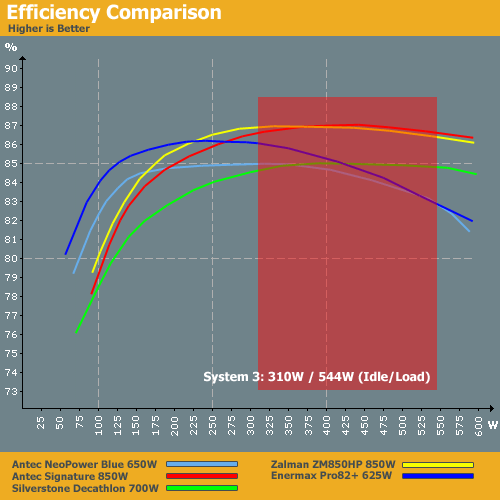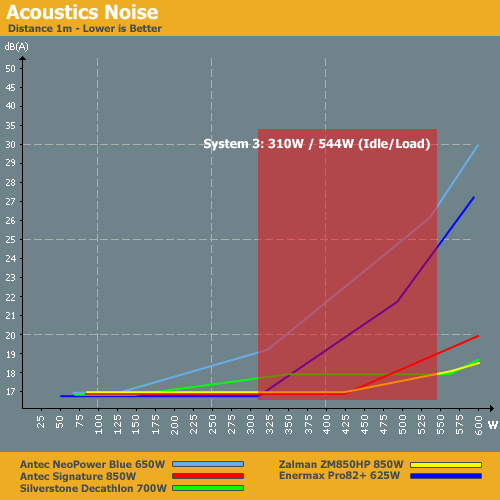Debunking Power Supply Myths
by Christoph Katzer on September 22, 2008 3:00 AM EST- Posted in
- Cases/Cooling/PSUs
PSUs for High-End Systems
Even though our high-end system consumes more power, we used the same graph layout. That means the resulting graphs stop at 600W, despite the high-end PSUs all being capable of providing more power than that. Our high-end system sports an SLI setup using two NVIDIA 8800 ultra cards; 3-way SLI would be a bit more demanding, but we don't feel it's a good indication of what people are actually running. The third card would also only add another 50W to 90W of power consumption to our system, since the third card is rarely taxed as much as the first GPU.
- Antec NeoPower Blue (650W) actively cooled
- Antec Signature (850W) actively cooled
- Silverstone Decathlon (700W) actively cooled
- Zalman ZM850HP (850W) actively cooled
- Enermax Pro82+ (625W) actively cooled

We've included the Enermax Pro82+ 625W from the midrange selection as well. Again, efficiency is not the major issue when it comes to choosing between these products. The two lowest rated power supplies -- Antec NeoPower 650W and Enermax Pro82+ 625W -- are less efficient over the tested range, but that's expected. The results all of her around 85% to 87% mark, and one or 2% difference really isn't going to matter much. Still, the Zalman and Antec 850W units place at the top of this chart.

Again, the two power supplies with the lowest output rating perform worse in this test, generating much more noise than the competition. The higher rated units don't have to work as hard, since they are running at a medium load. Those three PSUs remain very quiet along with providing better efficiency, making them the better for a high-end setup. The Zalman and Antec Signature 850W units would be our choice, if only for the extra headroom. Either PSU would have no difficulty with a 3-way GPU setup, provided you have sufficient PEG connections available. That brings up the next topic of discussion.










98 Comments
View All Comments
Christoph Katzer - Monday, September 22, 2008 - link
Yes I guess that was the problem. Thanks for pointing that out!ViRGE - Monday, September 22, 2008 - link
Christoph, thanks for the excellent article. There is one thing I noticed however that has me a bit confused. In a few of your video card tests, you have the cards pulling upwards of 100 watts from the PCIe slot. It has been my understanding, and is mentioned in AT's X38 chipset article*, that the limit for a PCIe slot is 75W. Your results put this value in contention, so I'm not sure what to believe at this point.Is it that I am mistaken that the limit is 75W, or are your video cards pulling too much power from the slot, or is there a problem with the data?
Christoph Katzer - Monday, September 22, 2008 - link
Thanks. The data is correct since the cards draw power through the PCIE slot and the additional PEG connectors (6-pin or 8-pin). Towards the end of the article you will find a list which card drew how much power from the PCIE slot and the PEG connector. 75 watts is however correct for the older PCIE slots, PCIE2.0 can draw up to 150 watts.mobutu - Monday, September 22, 2008 - link
Where is AMD 4850?Also almost all the graph cards used are kind of old, previous generation.
Dobs - Monday, September 22, 2008 - link
Here is a link to a comprehensive list of all graphics cards.Dobs - Monday, September 22, 2008 - link
damn... link didn't workCopy and paste :)
http://archive.atomicmpc.com.au/forums.asp?s=2&...">http://archive.atomicmpc.com.au/forums.asp?s=2&...
Clauzii - Monday, September 22, 2008 - link
Nice lists, thanks :)Christoph Katzer - Monday, September 22, 2008 - link
As stated I didn't have all of the new stuff here and this article anyway focuses primarily on power supplies and how to choose them and not the power consumption of the components... but it might come soon, who knows.LTG - Monday, September 22, 2008 - link
>>our labs don't have the latest GPUs available for testingIsn't this kind of a bad thing for a site with so many enthusiast readers?
First two caveats:
1) There are a lot of article bashers out there who nit-pick, give rude feedback, or are just plain wrong, I don't support these guys or want to be one.
2) The article written was very good and helpful, thank you.
However it doesn't matter that the article "primarily focused on how to choose power supplies".
- Leaving out a GTX 280 was a big omission. Even better to have an stock OC'd product.
- Leaving out very basic overclock numbers was a big omission. For example it's very common for readers to have an Intel QC clocked at 3.6Ghz since it's so doable.
Having the last two data points would be very helpful for those building top systems, and would even be interesting for those who are not.
7Enigma - Monday, September 22, 2008 - link
As mentioned, the article is about the myth that we all need 1k PSU's for the "best experience". Bottom line this article shows that the vast majority of people do not need more than a 500-600w psu. How is leaving out any stock product an omission? Just look at the TDP of the product and go from there. All stock products will fall within a narrow range.Once you get to OC'ing I also think this is a difficult thing to do. Individual chips, even from the same batch can have very different properties and require different voltages to reach the same speeds. I'm sure if the author had put that his Intel quad drew 120w at 3.6GHz, someone would have complained that their's took 135w, and someone else only 110w...Once you go above stock, it is not cut and dry and as the article states you should have a 20-30% extra buffer if you wish to OC.
I feel the scope of the article just doesn't require these extra requests. Sure it would be nice to see just how crazy of a system you can make (if I remember correctly they did that a while ago to actually use the >1000w supplies), but this article was to show what a normal base, mid-grade, and high-end setup would require.
I've complained in the past about articles, but this one I don't see any serious faults.